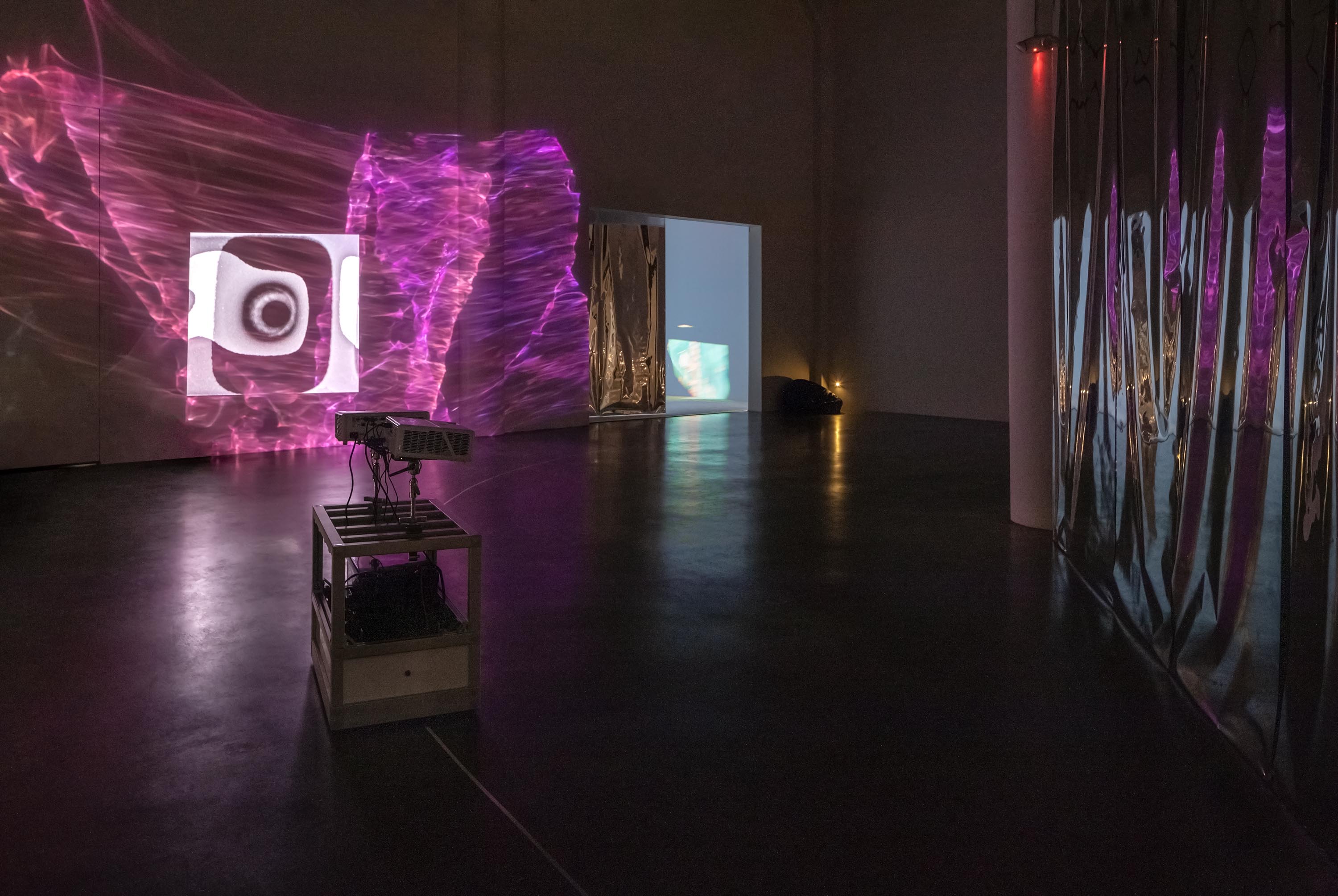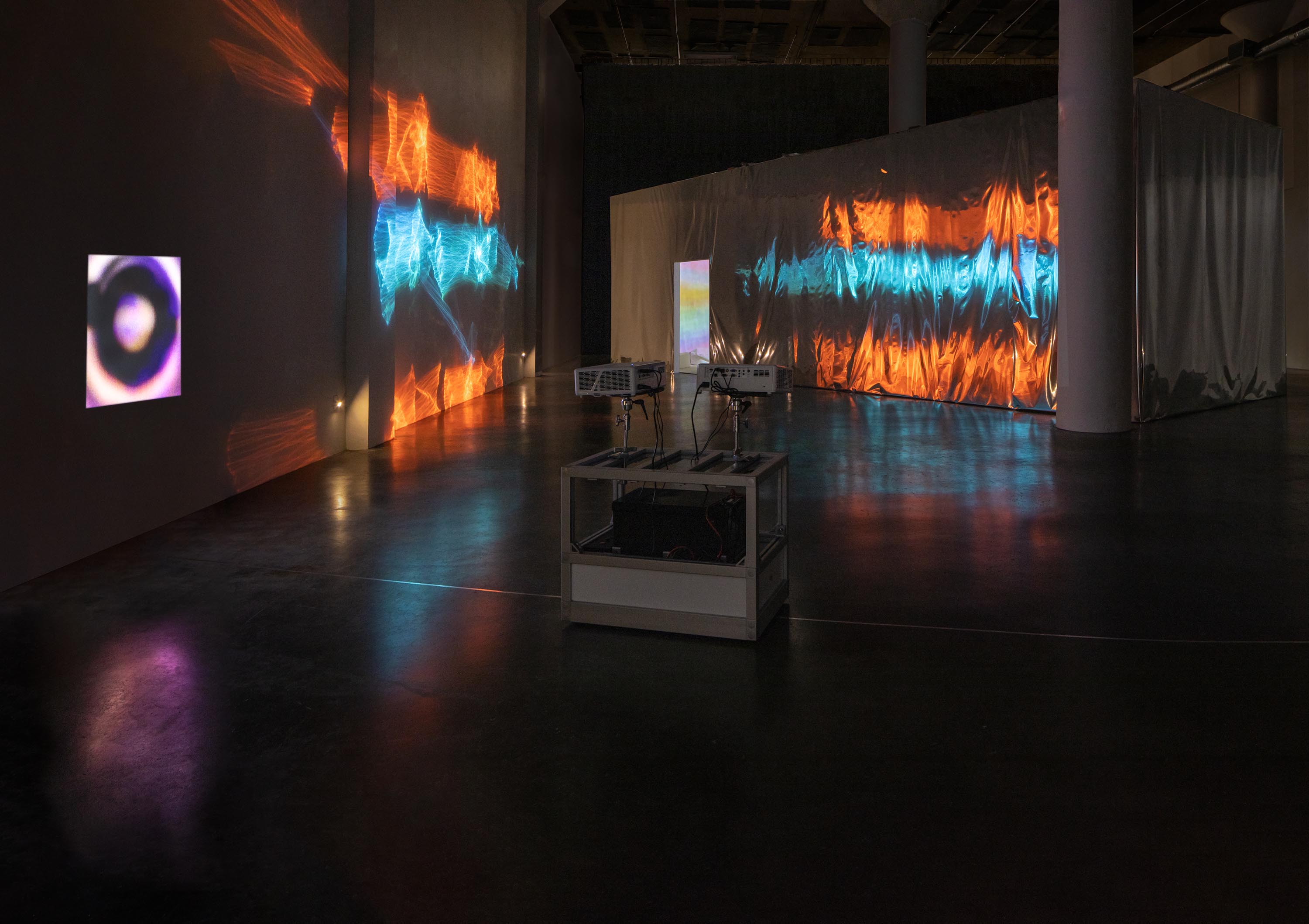ZOOM BLUE DOT
1990–2020
Two-channel kinetic video installation (color, Sound "ZBD5" and "ZBD6" by Phill Niblock) projectors, Mylar curtain, Mylar tape, custom robotics.
In Zoom Blue Dot, Bull.Miletic addresses the proxistant paradigm as a predominant component in the overly mediated representation of Earth as a scalable interface, facilitated through a combination of remote-sensing technologies and data-analysis software.
In 1990, the Voyager 1 space probe pointed one of its cameras towards the Earth to snap one last photo. In this photograph, shot from a distance of roughly 4 billion miles, the Earth was essentially mapped into a crescent at only 0.12 pixel in size. One of the initiators of this photograph, astrophysicist and space exploration evangelist, Carl Sagan, poetically described it best; “the Earth appeared as a glimmering speck of dust, a pale blue dot suspended in a sunbeam.”
In Zoom Blue Dot, Bull.Miletic focuses on the proxistant Earth models produced with data obtained by orbiting satellites combined with ground and airborne imaging. In regards to Earth’s depiction as a speck of dust photographed by a spacecraft from a distance of 4 billion miles, this inquiry into proxistance is concerned primarily with the question of scale.
As they delved into this project, the artists investigated a number of proxistant visions of Earth. This research led them to discover an historic effort had been made to visualize, identify, and control the world as a unified globe. Here, different conceptions of scale guided a proxistant journey in which the most distant image of Earth meets the solid materials of rocks and crystals, where scientific models of calculation and prediction shaped an artistic vision, beyond visualization.
The videos Bull.Miletic created in this installation are inspired by the visual communications research conducted by the American design couple Ray and Charles Eames in their legendary films Powers of Ten (1977) and A Rough Sketch (1968). However, as opposed to the Eameses’ camera, which travels from the outer limits of the observable universe into the molecular structure of the human body, the camera in Zoom Blue Dot zooms into the “pale blue dot” image of Earth. The artists displayed this image on two iPhones placed in the desert.
By diving into the smartphone screens with both laser and electron microscopes, the artists were able to study the different layers that make up the phones’ liquid crystal displays, and thus uncover this proxistant vison’s material support.
This effort was motivated by a desire to understand how the proliferation of scalable and composited mediations of Earth is inextricably tied up in multiple ways with the Anthropocene, a proposed name of our geological epoch that signals the significant human impact on Earth’s geology and ecosystems. Smartphones, for example, can contain 30 different elements, including rare earth materials like cobalt, tungsten, and lithium. These materials require extensive mining, resulting in considerable environmental, social, and political impact.
The walls of the exhibition are covered with a reflective Mylar curtain. A 1950’s American invention, metallic Mylar is a heat resistant, reflective film largely used both in space exploration and LCD technologies. Micro movements in the reflective curtain, caused by the airflow in the room, intentionally produce continuous deformations and changes in the projected images; reflecting the ongoing process of becoming, rather than being.
The acclaimed American composer, Phill Niblock, created the original soundtrack for Zoom Blue Dot’s installation, which is intentionally out of sync with the video. The relationship between the sound and imagery, like Earth, is in perpetual development.
Niblock’s composition is also periodically “interrupted” by fragments of selected compositions from the Voyager’s Interstellar Record (1977). This way, the Voyager 1 journey also becomes part of the Zoom Blue Dot soundscape - delivering the hopes and dreams of future connections with the unknown in outer space.
The production of Zoom Blue Dot was generously supported by the Arts Council Norway, and the UC Berkeley Arts Research Center and Center for Science, Technology, Medicine, & Society. The work was realized on site, in Berkeley, during the inaugural, Arts + Science Residency in collaboration with Holly L. Aaron, at the Molecular Imaging Center, Danielle Jorgens at the Electron Microscopy Laboratory, Vasfi Burak Ozdol at the Molecular Foundry, Lawrence Berkeley National Laboratory and Christopher Myers and Kuan-Ju Wu at CITRIS Invention Lab.


